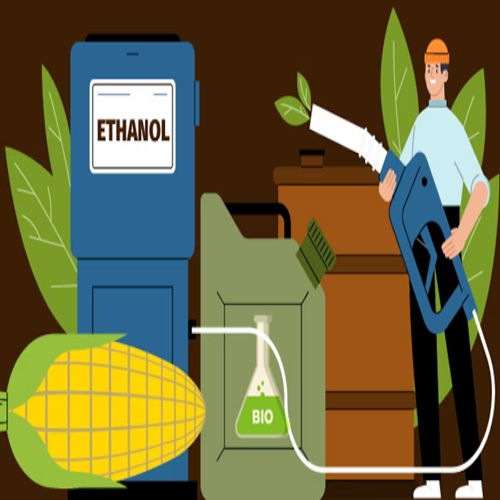Ban on use of sugarcane juice for ethanol to hit fuel-blending target, sugar mill revenues

The centre will find it difficult to meet the ethanol fuel-blending target after yesterday’s notification prohibiting the use of sugarcane juice, or syrup, for its production in 2023-24.
Out of the total ethanol production, around 28 percent is from sugarcane juice, which also fetches the maximum price for the sugar mills, at Rs 65.61 per litre. So, this step is likely to hit the earnings of the sugar mills. The share prices of major sugar companies have already fallen after the decision
Over 50 percent of the ethanol comes from the sugar by-product B-heavy molasses, which the government has not banned. Its current rate is Rs 60.73 per litre. Little over one percent is produced from C-heavy molasses, which carries the lowest price of Rs 49.41 per litre.
The government’s move was perhaps to check a drop in sugar output following reports of a possible shortfall.
Ethanol output
Sugar industry experts reckon that a lower sugar production this year would reduce the ethanol output, and this decision could further aggravate the situation and prevent the Centre from attaining the ethanol fuel blending target. In 2022-23, the country achieved 12 percent fuel-blending, and in the current year, it is looking at raising it to 15 percent. The Centre has targeted 20 percent ethanol blending in petrol by 2030.
Of the total quantity of ethanol required for fuel-blending, 80 percent comes from the sugar industry, another 18 percent from rice, and the rest from damaged food grains.
“Last year, the ethanol produced from sugarcane juice was in the range of 90 to 100 crore litres. After the current decision, sugar output could go up by 1 to 1.2 million tonnes,” said Hemanth Gowda, Research Head of Agrimadni.live, a research organisation dealing with agri-commodities.
A senior executive of a sugar mill said the step would hit the earnings of sugar mills, but he decided to wait for further clarity on the existing stocks before making any further comments.
Drop in sugarcane production
With a shortfall expected in Maharashtra and Karnataka, the sugar industry has predicted lower production this year. These two states, along with Uttar Pradesh, account for the majority of the sugar output in the country.
The advance estimate of the Indian Sugar Mills Association (ISMA) that was released at the end of October pegged the gross sugar production at 33.7 million tonnes in 2023-24 (October to September), compared to over 36.6 million tonnes in the previous year. The diversion of ethanol from the sugar sector for fuel blending was 4.1 million tonnes from the gross output in 2022-23.
But in the current year, if around 4 million tonnes are diverted for ethanol, sugar production could drop to 29.7 million tonnes. Since ISMA estimates domestic consumption to be at 27.85 million tonnes, it leaves a buffer stock of around 2 million tonnes.
As a result, the diversion of ethanol from the sugar industry could be less this year. “The industry expectation is 3.5 to 3.7 million tonnes this year,” said Atul Chaturvedi, Executive Chairman of Shree Renuka Sugars.
But after the recent decision and the current state of sugar production in the country, even that may not be possible, according to Gowda. “It could come to a low of 1.5 to 2 million tonnes,” he said.
However, the decision not to use sugarcane juice for ethanol could raise the overall sugar production to around 31 million tonnes.
At present, a 25 percent drop in sugar output is expected in Maharashtra, while the production in Karnataka is also down. However, the situation could improve with the rains next month, Gowda said. A marginal increase in sugar output is expected in Uttar Pradesh.
“If El Nino sets in this year, then it could have a lagging effect, affecting production next year too. If that happens, then the supply of ethanol to oil marketing companies could come down to even 1 million tonnes next year,” he explained.
The government has already banned the export of some varieties of rice this year as the supply has fallen. In the circumstances, it would be difficult for it to raise ethanol supply from the rice industry, it is pointed out.
The industry is eagerly waiting for the ethanol policy to state the quantity of diversion and the rates. The ethanol supply year is from December to November. “But this year the government has not announced the policy, which usually comes before the start of the supply year. Though we are expecting a 5 percent hike in ethanol rates, it may not happen in the current and next year as the sugar output will be lower,” Gowda said.
Demand for higher rates
The sugar industry has been demanding higher rates for ethanol supplied by it, and a hike in the minimum selling price (MSP) of sugar from the current Rs 31 per kg, to offset losses from the sales of sugar. The government had raised the price given by the mills to sugarcane farmers by Rs 1 to Rs 31.5 per kg earlier this year, which has now raised the cost of production of the mills. According to them, the current MSP has been unchanged in the last few years.
Given the reduction in sugar supply, exports may be considerably less this year. “Maybe it could be as low as 5 lakh tonnes, with the government allowing consignments to neighbouring countries such as Nepal and Bhutan,” he pointed out. Exports touched 6 million tonnes last year, down from 11 million tonnes in 2021-22.
Wholesale sugar prices are hovering in the range of Rs 38-42 per kg. Though sugar production is less, Gowda feels lower diversion of ethanol could result in a slight drop in prices.
What ISMA has to say
The Indian Sugar Mills Association (ISMA), which represents the major sugar mills in the country has said that the recent decision of the government to restrict the use of sugarcane juice for ethanol production will hit the sugar mills and the farmers.
In a statement issued on December 8 evening, the association said the step will cause the crushing capacity of the sugar mills to decline drastically resulting in loss for the sugar mills and farmers as the crushing season will be delayed. The payments to the farmers could get stretched and they would not be able to clear the sugarcane field in time for further use.
ISMA suggested allowing the conversion of the remaining contracted or cancelled juice quantity to B-heavy molasses to provide the oil marketing companies with additional ethanol without significantly affecting sugar production. The step will also help maintain the continuity of ethanol supply for the ethanol blending programme.
To avoid disruptions and ensure a smooth transition, ISMA has requested permission for distilleries to continue processing existing sugarcane juice to ethanol until December 10 and to supply it to oil marketing companies until December 20.
Further to prevent potential delay or defaults in farmer payments owing to reduced ethanol production from juice and syrup, ISMA has proposed a compensatory increase in prices of ethanol derived from B and C heavy molasses.

















